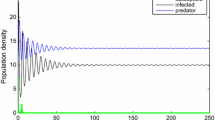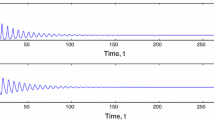Abstract
The disease effect on ecological systems is an important issue from mathematical and experimental point of view. In this paper, we formulate and analyze a predator–prey model for the susceptible population, infected population and their predator population with modified Leslie–Gower (or Holling–Tanner) functional response. Mathematical analysis of the model equations with regard to invariance of nonnegativity and boundedness of solutions, local and global stability of the biological feasible equilibria and permanence of the system are presented. When the rate of infection crosses a critical value, we determine that the strictly positive interior equilibrium undergoes Hopf bifurcation. From our numerical simulations, we observe that the predation rate also plays an important role on the dynamic behavior of our system.
Similar content being viewed by others
References
Anderson, R.M., May, R.M.: Infectious Diseases of Humans, Dynamics and Control. Oxford University Press, Oxford (1991)
Li, M.Y., Graef, J.R., Wang, L.C., Karsai, J.: Global dynamics of a SEIR model with a varying total population size. Math. Biosci. 160, 191–213 (1999)
Anderson, R.M., May, R.M. (eds.): Population Biology of Infectious Diseases. Springer, Berlin (1982)
Kuang, Y., Beretta, E.: Global qualitative analysis of a ratio dependent predator prey system. J. Math. Biol. 36, 389–406 (1998)
Saez, E., Gonzelez-Olivares, E.: Dynamics of a predator–prey model. SIAM J. Appl. Math. 59, 1867–1878 (1999)
Jost, C., Arino, O., Arditi, R.: About deterministic extinction in ratio-dependent predator–prey models. Bull. Math. Biol. 61, 19–32 (1999)
Xiao, Y.N., Chen, L.S.: Modelling and analysis of a predator–prey model with disease in the prey. Math. Biosci. 171, 59–82 (2001)
Chattopadhyay, J., Arino, O.: A predator–prey model with disease in the prey. Nonlinear Anal. 36, 747–766 (1999)
Chattopadhyay, J., Pal, S., El Abdllaoui, A.: Classical predator–prey system with infection of prey population – a mathematical model. Math. Methods Appl. Sci. 26, 1211–1222 (2003)
Venturino, E.: The influence of disease on Lotka–Volterra systems. Rocky Mountain J. Math. 24, 389–402 (1994)
Aziz-alaoui, M.A., Daher Okiye, M.: Boundedness and global stability for a predator–prey model with modified Leslie–Gower and Holling-type II type schemes. Appl. Math. Lett. 16, 1069–1075 (2003)
Guo, H.J., Song, X.Y.: An impulsive predator–prey system with modified Leslie–Gower and Holling type II schemes. Chaos, Solitons Fractals 36(5), 1320–1331 (2008)
Song, X.Y., Li, Y.F.: Dynamic behaviors of the periodic predator–prey model with modified Leslie-Gower Holling-type II schemes and impulsive effect. Nonlinear Anal. Real World Appl. 9(1), 64–79 (2008)
Kuang, Y.: Delay Differential Equations with Applications in Population Dynamics. Academic Press, London (2004)
Butler, G., Freedman, H.I., Waltman, P.: Uniformly persistence system. J. Proc. Am. Math. Soc. 96, 425–430 (1986)
Freedman, H.I., Waltman, P.: Persistence in a model of three competitive populations. Math. Biosci. 73(11), 89–101 (1985)
Freedman, H.I., Moson, P.: Persistence definitions and their connections. Proc. Am. Math. Soc. 109, 1025–1033 (1990)
Hale, J.K., Waltman, P.: Persistence in infinite-dimensional systems. SIAM J. Math. Anal. 20, 388–396 (1989)
Author information
Authors and Affiliations
Corresponding author
Additional information
This work is supported by the National Natural Science Foundation of China (No. 10771104 and No. 10771179) and Program for Innovative Research Team (in Science and Technology) in University of Henan Province.
Rights and permissions
About this article
Cite this article
Zhou, X., Cui, J., Shi, X. et al. A modified Leslie–Gower predator–prey model with prey infection. J. Appl. Math. Comput. 33, 471–487 (2010). https://doi.org/10.1007/s12190-009-0298-6
Received:
Revised:
Published:
Issue Date:
DOI: https://doi.org/10.1007/s12190-009-0298-6




